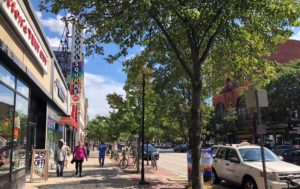Looking Back on 2019: What Have We Learned?
By Perri Meldon, Program Manager
As program manager of the Cambridge Historical Society in 2019, I relished the opportunity to learn “How Does Cambridge Engage?” While I cannot revisit all the excellent events we held, I would like to share some lessons I’ve gleaned.
The year kicked off with our Opening Conversation, where Dr. Karilyn Crockett addressed the Inner Belt protests. She argued that each of us is an “embodied archive,” and that the stories we carry matter and have the power to shape history.
In early spring, we welcomed City Councilors Alanna Mallon and Sumbul Siddiqui to discuss digital tools as a platform for engagement. We learned how podcasts and social media can serve as equalizers by bringing politics to the people, through our internet speakers and screens. They imparted to us the need for greater representation of women in politics, highlighting the 2018 elections as a model for challenging historically, white, male-dominated spaces.
Drs. Stephen Berrey and Tatiana Cruz discussed how we grapple with so-called “difficult histories” in June. We asked ourselves and the audience: Who are they difficult for, and why? We learned that in order to make structural changes within our communities and the institutions we engage with, we must first confront legacies of unequal representation and the disenfranchisement of certain groups of people that continue to inform our understandings of race, gender, and class today. This is an ongoing process that requires authentic commitment with input from many stakeholders.
This summer we also strolled through Central Square on our walking tour, which focused on legacies and ongoing commitment to activism in the neighborhood. Our tour intern, Amelia Zurcher, found that Central Square plays a symbolic role in Cambridge as a shared and public space for community-building in the city.
We have reflected on the Society’s annual theme of engagement not only through our programs, but through our archival collections as well. Historic materials, such as the Old Mole, have much to tell us about the ways people protested, responded to, or mobilized for change in the past. The Old Mole (1968-1970) was a leftist underground newspaper based in Central Square. During the Harvard strike of 1969, the biweekly paper published “Strike Specials.” The paper garnered attention when it published internal letters and memos taken from Harvard administrative offices during the University Hall occupation. These documents demonstrated the ties between Harvard University and the CIA, and shed light on the administrative resistance to student and faculty demands to abolish the ROTC.

Other objects show us how communities in Cambridge gathered to support friends and family near and far. The 1917 Honor Flag was awarded to members of the Bee, a Cambridge women’s organization, for their success at selling liberty bonds during World War I. The Bee, originally called the Banks Brigade, was formed in November 1861 when a group of teenagers committed to making socks and other goods for Union soldiers during the Civil War. Excluded from the vote and barred from serving as regular members of the military, girls and women turned to craft as a form of political engagement. The Bee disbanded in 1931, but craft as a form of engagement and activism continues to this day.

What lingers with me most are the lessons derived from Fall Conversation, in which we asked “How Can We Make Change Here?” Moderator Mary McNeil led educators Dr. Charlotte Ryan and Cheyenne Wyzzard-Jones in a discussion of how they became activists and the tools they believe are necessary to make change. The panelists agreed that essential to change-making is the ability to draw on your own strengths and identify who you can trust, rely on, and feel safe with. Likewise, it is necessary to establish dialogue across communities and generations. Ultimately, activism is about having respect and humility for others as you build on your community’s history.
Looking back on this year, we at the Cambridge Historical Society find that the city draws on a long history of activism and civic engagement, which is not limited to the “golden age” of 1960s protest but runs throughout our history to the present day. This commitment to active participation is woven into the landscape, the universities, and the array of social services established and directed by city residents. Taking action, we have learned, is not limited only to specific moments in time—like protests against the American War in Vietnam—but should address ongoing issues—including the push for women’s equality and responding to climate change.
It has been an honor to listen to and learn from so many who have shaped and continue to make the city a better place for all. We look forward to learning more about our city’s leaders for change as we focus next year’s program on the question, “Who Are Cambridge Women?” Please join us in 2020 as we explore this theme.
Perri Meldon


